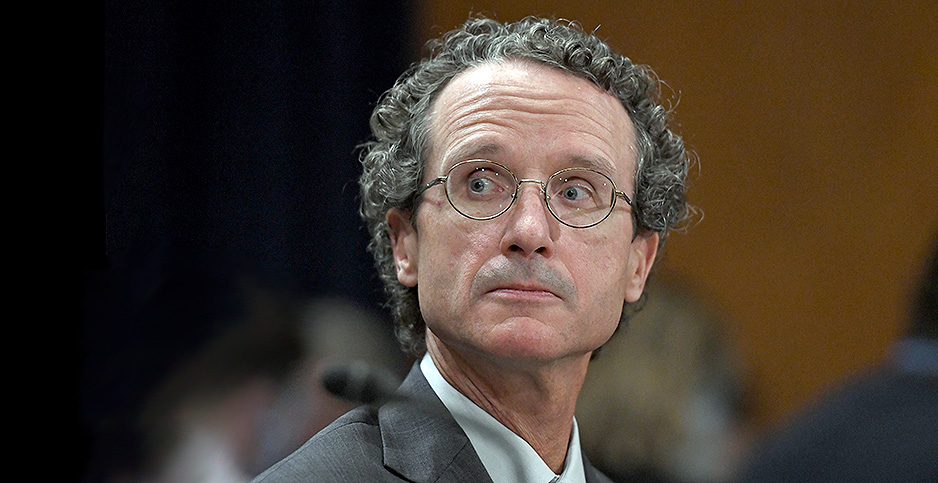EPA May Spin Off Disputed Changes in Clean Power Plan Redo

By Sean Reilly
June 10, 2019 - When EPA unveiled its proposed replacement for the Obama-era Clean Power Plan last summer, the draft blueprint came attached with a big add-on: a dramatic easing of air pollution permitting requirements for power plant upgrades.
But as the agency barrels toward release of the final version of the Affordable Clean Energy rule by the end of this month, that change to the New Source Review program could be jettisoned for now, according to people in the business, environmental and regulatory communities.

EPA air chief Bill Wehrum testifies before the Senate Environment and Public Works Committee in October 2017.
Photo by Ron Sachs, dpa/picture-alliance/Newscom
"I wouldn't be surprised if they did them separately," Jeffrey Holmstead, who headed EPA's air office during President George W. Bush's administration and is now a partner at the law firm of Bracewell LLP, said in a Friday interview.
At the Natural Resources Defense Council, John Walke called that prospect "all but a certainty."
"We have not seen the final draft rule, but every single indication consistently we have heard is that the NSR package is being spun off," said Walke, the group's clean air director.
While EPA air chief Bill Wehrum has described that package as complementary to the agency's broader strategy in the ACE proposal, influential industry players such as the Utility Air Regulatory Group have voiced concerns about its workability.
In addition, manufacturers and other business sectors also covered by New Source Review permitting requirements want the same treatment as that offered to power producers. Miles Keogh, executive director at the National Association of Clean Air Agencies, said in a Friday email that he's heard EPA will now bundle the New Source Review revamp into a broader rulemaking this fall.
At an April congressional hearing, EPA Administrator Andrew Wheeler acknowledged the possibility of dropping that plank from the final version of the ACE rule. If so, the agency would tackle it separately, Wheeler told members of a House Energy and Commerce subcommittee. "We will move forward with both pieces," he said.
As of this morning, the final draft remains under review by the White House's Office of Information and Regulatory Affairs, according to a government tracking website. But the agency wants to release it soon. Wheeler is tentatively slated to meet with President Trump this week about the rule's rollout; the White House wants to be involved in its announcement, according to a senior EPA official.
Trump has made protection of the coal industry a signature issue. A White House spokesman had no on-the-record comment on the possibility of a meeting between Wheeler and the president this week.
As of this morning, EPA spokesman John Konkus had not replied to a Friday email seeking confirmation of the agency's plans for the ACE rule. The agency has also not responded to an interview request made weeks ago with Wehrum on the topic.
Unlike the 2015 Clean Power Plan, which took a systemic approach to reducing greenhouse gas emissions from coal-fired generating plants, the ACE proposal released last August focuses on improving the operating efficiency of individual facilities.
The New Source Review program requires plant operators to get pre-construction permits for upgrades or expansions expected to lead to more pollution.
Under the draft ACE rule, however, states could adopt a new yardstick for gauging whether such upgrades trigger the need for a New Source Review permit. Now, companies must forecast the potential effect on overall yearly air emissions. The ACE proposal would allow states to substitute a more lenient approach tied to whether the project would lead to a higher hourly emissions rate.
Earlier this year, Wehrum told a gathering of state utility regulators that the ACE strategy — with its emphasis on improved power plant efficiency — wouldn't work otherwise. "NSR would stand in the way of the implementation of those efficiency projects and likely make viable projects nonviable," Wehrum said at the time.
But Wehrum, who also worked in the EPA air office during the Bush administration, has a long-standing interest in revamping the New Source Review program. Environmental groups have objected that the planned change is a giveaway to coal firms.
In releasing the ACE plan last August, EPA made clear that the New Source Review provisions were legally "severable," meaning it wouldn't kill the entire rule should a judge strike them down.
Once the rule is made final, a barrage of legal challenges is virtually certain. Compared with what would have happened under the Clean Power Plan, power plant emissions of carbon dioxide, sulfur dioxide and nitrogen oxides are all expected be higher under the ACE rule, according to a recent analysis by Resources for the Future, a centrist think tank. But the increases would be more pronounced if the New Source Review overhaul were included in the final rule, the analysis found.
"This complicates EPA's stated justification for NSR reform, which is that it would enable coal plants to efficiently reduce their carbon emissions," Amelia Keyes, a research associate for Resources for the Future, wrote in a blog post.
The Utility Air Regulatory Group, which has traditionally represented electric companies dependent on coal-fired generation and recently announced it is disbanding, had different grounds for its misgivings about the proposed ACE rule. EPA's previous New Source Review program enforcement actions "represent a barrier" to power companies undertaking some efficiency projects, attorneys for the organization wrote in comments filed last October.
"Without steps from EPA to provide regulatory certainty that these measures will not trigger NSR, [power plant] owners and operators may still be hesitant to undertake these projects," they wrote.
With the final rule set for completion this month, at least eight industry, environmental and regulatory organizations have recently met with staff from EPA and the Office of Information and Regulatory Affairs, according to online records, with two more such meetings scheduled this week. Among the organizations weighing in are two from outside the power sector: the National Association of Manufacturers and the American Forest and Paper Association, the records indicate.
NAM press staffers did not reply to a Friday email seeking comment on the association's reason for offering feedback on the proposed rule. In a statement released today through a spokeswoman, Paul Noe, vice president for public policy at the forest and paper association, said that its meeting "was an opportunity to advocate for regulatory certainty related to our industry's use of bioenergy, which is critical to our manufacturers' future and their global competitiveness.
"Professional staff from OIRA and EPA were at the meeting and gave careful thought and a fair hearing to our concerns," Noe added.

